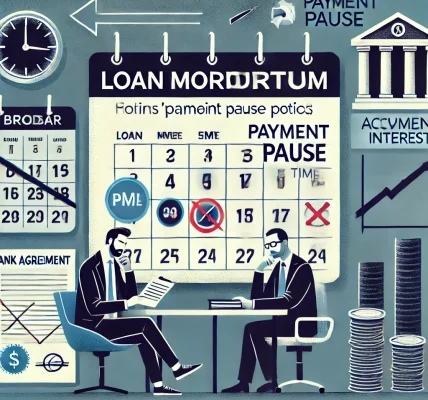Introduction
Loan prepayment is a financial strategy that many borrowers consider to reduce their overall debt burden. It involves making early payments on a loan before its scheduled tenure ends. While it can have significant benefits, including lower interest payments and financial freedom, it also requires careful consideration within the framework of financial planning. This article explores the impact of loan prepayment on financial planning, helping you understand whether it is the right move for your financial well-being.
Understanding Loan Prepayment
Loan prepayment refers to paying off a portion or the entire outstanding balance of a loan before its due date. It is commonly seen in home loans, personal loans, car loans, and business loans. There are two types of loan prepayments:
- Full Prepayment – Paying off the entire loan amount before the end of the tenure.
- Partial Prepayment – Making additional payments toward the principal amount, reducing the remaining tenure or EMIs.
Each type has its own implications and should be assessed based on individual financial goals and circumstances.
Benefits of Loan Prepayment
1. Interest Savings
Interest constitutes a significant portion of loan repayment, especially in long-term loans like home loans. By prepaying a loan, you reduce the principal amount, thereby reducing the total interest payable.
2. Reduction in Loan Tenure
When you make a prepayment, it either reduces the loan tenure or decreases the EMI amount. If you opt to keep EMIs constant, your loan tenure shortens, allowing you to become debt-free sooner.
3. Enhanced Credit Score
Paying off loans early reflects positively on your credit report, improving your creditworthiness. A high credit score can help you secure better financial products in the future.
4. Lower Financial Stress
Debt repayment can be a significant burden. By prepaying, you reduce your monthly financial commitments, giving you more disposable income for investments or savings.
5. Freedom to Reallocate Funds
Once your loan is prepaid, the amount that was previously allocated toward EMIs can be used for other financial goals, such as investments, retirement savings, or emergency funds.
Drawbacks of Loan Prepayment
1. Prepayment Penalties
Some loans, especially fixed-rate loans, have prepayment charges. These penalties may offset the interest savings, making prepayment less beneficial. It is essential to check loan terms before deciding.
2. Liquidity Constraints
Using a large sum of money for prepayment may deplete your cash reserves. This could impact your ability to handle emergencies or take advantage of investment opportunities.
3. Potential Tax Benefits Loss
In some cases, loan repayments provide tax benefits. For example, home loans offer deductions under sections 80C and 24(b) of the Income Tax Act. If you prepay a loan, you may lose these benefits.
4. Missed Investment Opportunities
If the expected return on investments is higher than the savings from prepayment, it might be better to invest surplus funds instead of prepaying the loan. A financial advisor can help determine the best course of action.
Factors to Consider Before Loan Prepayment
1. Type of Loan
The impact of prepayment varies across different types of loans. Home loans, car loans, and personal loans have distinct structures and benefits. Understanding your specific loan contract is crucial.
2. Prepayment Charges
Review your loan agreement for any prepayment penalties. Some financial institutions waive these charges, while others impose fees that could negate potential savings.
3. Interest Rate Comparison
If you have multiple loans, prioritize prepaying the one with the highest interest rate. This maximizes savings and reduces overall debt faster.
4. Financial Goals and Liquidity Needs
Ensure that prepaying the loan does not compromise your financial goals, such as emergency savings, retirement planning, or education funds.
5. Alternative Investment Options
Compare the potential returns from investments versus the interest savings from prepayment. If investments yield higher returns, allocating funds to them may be more beneficial.
Best Strategies for Loan Prepayment
1. Start with High-Interest Loans
Prioritize repaying loans with high-interest rates, such as credit card debt and personal loans, before low-interest loans like home loans.
2. Use Windfalls Wisely
Bonuses, tax refunds, or unexpected cash inflows can be directed toward loan prepayment without affecting your regular finances.
3. Increase EMI Contributions
If full prepayment is not feasible, consider increasing your EMI contributions to gradually reduce the principal amount.
4. Make Lump Sum Payments
Whenever possible, make lump sum payments to reduce the outstanding principal. Even occasional extra payments can significantly impact loan tenure and interest costs.
5. Assess Before Making a Decision
Consult with a financial advisor to analyze the pros and cons of prepayment in your specific financial context.
Conclusion
Loan prepayment can be an effective tool for financial planning if done strategically. It reduces debt burden, lowers interest costs, and enhances financial freedom. However, it is essential to evaluate prepayment penalties, liquidity needs, tax benefits, and investment alternatives before making a decision. By aligning loan prepayment with broader financial goals, you can optimize your financial health and achieve long-term stability.
Before making any financial decisions, always seek advice from a professional financial planner or consult your lender regarding the terms and conditions of prepayment. This ensures that your financial moves are both beneficial and risk-free.




